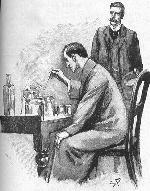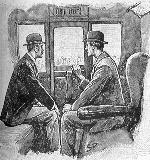| Greetings,
This is one of the most important of the canonical stories in
that it sets the stage for what is to come. It begins with
Holmes the prototype of the rational man then suddenly detours into a depiction
of Holmes the romanticist. Paget chooses to focus on this in his
depiction's for reasons that only become clear in the subsequent adventure
when Holmes meets his "death" in the corrupted natural surroundings of
the Victorian world.
 The
story begins with a strong depiction of Holmes the The
story begins with a strong depiction of Holmes the empiricist deciding the fate of "a man's life" by the color of a piece
of litmus paper. Surrounded by test tubes and beakers, the
scene is reminiscent of the beginning of RESI when Watson saves Holmes
from the depression brougtht about by the failure of his science to provide
him answers. This time however, the moo continues through the portrait
of the initial interview until suddenly Holmes is captivated by a rose.
While no satisfactory reason for this departure will ever be made, clearly
Paget takes Watson at his word that the scene presents another side of
Holmes - the romanticist who is not "the machine without a heart" as so
often depicted.
empiricist deciding the fate of "a man's life" by the color of a piece
of litmus paper. Surrounded by test tubes and beakers, the
scene is reminiscent of the beginning of RESI when Watson saves Holmes
from the depression brougtht about by the failure of his science to provide
him answers. This time however, the moo continues through the portrait
of the initial interview until suddenly Holmes is captivated by a rose.
While no satisfactory reason for this departure will ever be made, clearly
Paget takes Watson at his word that the scene presents another side of
Holmes - the romanticist who is not "the machine without a heart" as so
often depicted.
Less commented on, but equally important in the understanding
of the romantic Holmes is his later reverie in the train as they pass the
neighborhoods of London. To Watson "the view was
sordid."  But, it is the board schools Holmes points to approvingly , echoing
the theme of the democratic developed earlier when Watson noted that
the status of the nephew of Lord Holdhurst "did him little good at school."
Doyle has in a few pages established the superiority of British society
from appreciation of the natural world, to working class neighborhoods
to the "playing fields of Eton" and Paget capture it all admirably with
a few strokes of his pen.
But, it is the board schools Holmes points to approvingly , echoing
the theme of the democratic developed earlier when Watson noted that
the status of the nephew of Lord Holdhurst "did him little good at school."
Doyle has in a few pages established the superiority of British society
from appreciation of the natural world, to working class neighborhoods
to the "playing fields of Eton" and Paget capture it all admirably with
a few strokes of his pen.
As always, depicting relationships are
important to Paget. Paget chooses to depict Holmes deep in
an experiment while Watson, hat in hand, awaits his attentions. This
illustration of the patient and nervous subordinate is furthered by two
others. The
first is the interview with Percy where a cross legged Holmes sits next
to a stiff and straight seated Watson while Percy reclines on the Victorian
fainting sofa designed for the "weaker sex" who in this instance
who comforts him while he lies helpless. The second shows Holmes
equally relaxed in the presence of Lord Holdhurst while Watson, hat on
lap, sits ram rod straight staring at Holmes. The caption, The
first is the interview with Percy where a cross legged Holmes sits next
to a stiff and straight seated Watson while Percy reclines on the Victorian
fainting sofa designed for the "weaker sex" who in this instance
who comforts him while he lies helpless. The second shows Holmes
equally relaxed in the presence of Lord Holdhurst while Watson, hat on
lap, sits ram rod straight staring at Holmes. The caption,  "A
nobleman" can easily be taken as to be Watson's summary of his friend,
not the Lord in whose presence his body language emulates that he adopts
in deference to his friend in earlier portraits. "A
nobleman" can easily be taken as to be Watson's summary of his friend,
not the Lord in whose presence his body language emulates that he adopts
in deference to his friend in earlier portraits.
It is not until the mystery is solved that Watson is allowed to
relax. He sits with legs crossed as Holmes revels in
total relaxation and triumph in a leather covered lounge chair and asks
"Is there any other point which I can make clear?" A loaded question
of which the clearly drained Percy and relaxed Watson believe refers to
this case,  not
the contradictions of the one already boiling in Holmes' mind. not
the contradictions of the one already boiling in Holmes' mind.
Paget has made several points clear through his illustrations
in this important prelude to the tragedy to come.
Take Care
SP
Greetings,
The image of the science vs nature as
drawn by Paget are the most important themes to be drawn from "The Adventure
of the Naval Treaty." With these, Paget presents the two contradictory
sides of Holmes' character as well as set the stage for the events of the
"final" adventure.
The story is one of contrasts befitting its two part format.
Besides the contrasts of Romanticism and empiricism already referred
to, Paget draws the contrasts between classes and attitudes in NAVA.
 Lord
Holdhurst is "A nobleman" and Paget draws him and his chambers on Downing
street as such. He is dressed in even more formal wear than the formal
Victorian wear of Watson and Holmes who, surprisingly, remain seated in
his presence. A vest with a white shirt front topped with a cravat
beneath a starched collar. Lord
Holdhurst is "A nobleman" and Paget draws him and his chambers on Downing
street as such. He is dressed in even more formal wear than the formal
Victorian wear of Watson and Holmes who, surprisingly, remain seated in
his presence. A vest with a white shirt front topped with a cravat
beneath a starched collar.
On the floor, between two of the heavily worked
pieces dwellings, is an Oriental area rug - all popular in Victorian
upper class . Books - the sign of the intelligentia - line
the walls and a painting and perhaps a statue are situated above a fireplace.
The appointments, dress and attitudes speak to the confidence of the class
and its impeccable credentials as the rulers of an empire.
In stark contrast stands the squalid
housing and residents of No. 16 Ivy Lane, Brixton, a less fashionable address
than Downing street to be sure. Paget marks the contrast by depicting
a reversal of Lord Holdhurst class and dwelling.
Mrs. Tangey, taken aback by the rushing in
of the Holmes and Watson leans backwards against a table. Mrs. Tangey
of the Paisley shawl is dressed simply with a simple bonnet and dress that
reaches to the floor, one toe of a dark shoe sticking out.
The table and the chair - which
is the only other furnishing - are of common
place variety. The walls are bare and
save a few knack knacks - possibly kitchen utensils on the mantle above
the fireplace - the room is rough and utilitarian. The fireplace
in this dwelling serves not only for decor and for more than warmth as
the pans along its base indicate. No Oriental rugs break the plainness
of the floor in this workers dwelling.
Mrs. Tangey and her lazy husband who slept
by the whistling(?) coffee pot  while
the treaty was being whisked the other way are the soft underbelly of the
empire, and Holmes wishes and believes that those in the board schools
he and Watson whisk by will produce men who will build a "wiser, better
England of the future." Not soon enough to save Holmes from its corruption
that will engulf him in the next tale. while
the treaty was being whisked the other way are the soft underbelly of the
empire, and Holmes wishes and believes that those in the board schools
he and Watson whisk by will produce men who will build a "wiser, better
England of the future." Not soon enough to save Holmes from its corruption
that will engulf him in the next tale.
Take Care
SP
|